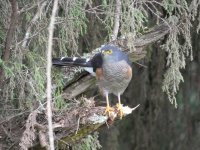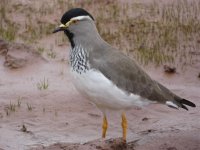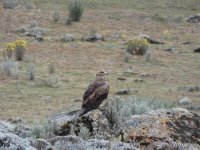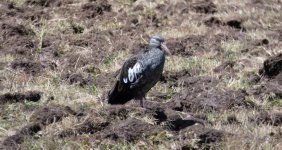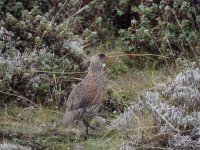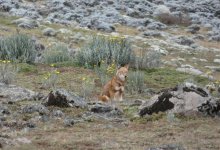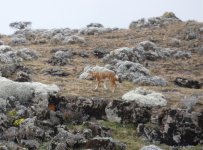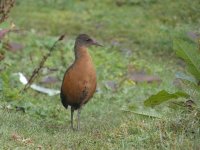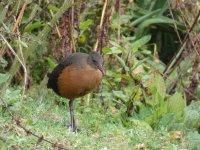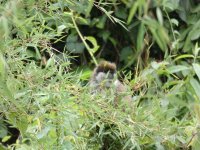-
Welcome to BirdForum, the internet's largest birding community with thousands of members from all over the world. The forums are dedicated to wild birds, birding, binoculars and equipment and all that goes with it.
Please register for an account to take part in the discussions in the forum, post your pictures in the gallery and more.
You are using an out of date browser. It may not display this or other websites correctly.
You should upgrade or use an alternative browser.
You should upgrade or use an alternative browser.
AMS, Gastroenteritis and birding in Ethiopia (1 Viewer)
- Thread starter dwatsonbirder
- Start date
More options
Who Replied?Andy Adcock
Worst person on Birdforum

Daniel, I realise just writing the report must be time-consuming enough, but is there any chance of labelling the (excellent!) photos? Most are completely alien to me!
Many thanks,
Chris
You can figure it out from the text
African Goshawk
Spot-breasted Lapwing
Tawny/ Steppe or Golden Eagle
Wattled Ibis
Moorland Francolin.
dwatsonbirder
Well-known member
Hi Chris, thanks for the kind words, I will do in future posts- admittedly I was being a bit lazy. Andy is correct, with the eagle being Steppe (long gape line and barring on the flight feathers) though I think the francolin is Chestnut naped rather than Moorland - happy to be corrected of course!
Edit: I can't seem to change the earlier posts, so here goes:
Post 2 - Abyssinian ground thrush, Abyssinian slaty flycatcher, Abyssinian LEO, African wood owl
Post 7 - Serval, Blue winged goose, Moorland chat, Augur buzzard, Mountain nyala
Post 8 - African black duck, Yellow fronted parrot, Abyssinian longclaw, Pied wheatear, Pallid harrier
Post 21 - see above
Edit: I can't seem to change the earlier posts, so here goes:
Post 2 - Abyssinian ground thrush, Abyssinian slaty flycatcher, Abyssinian LEO, African wood owl
Post 7 - Serval, Blue winged goose, Moorland chat, Augur buzzard, Mountain nyala
Post 8 - African black duck, Yellow fronted parrot, Abyssinian longclaw, Pied wheatear, Pallid harrier
Post 21 - see above
Last edited:
dwatsonbirder
Well-known member
22nd November - Rira - Sanetti - Goba
The day began with a pre-breakfast amble around the grounds of our accomodation at Rira Eco lodge, a rather grand title for a cluster of mud huts with no electricity or running water… There were quite a few birds in the area, with Tacazze sunbird, Baglafecht weaver, Streaky seedeater, Groundscraper thrush, Chiffchaff and Rufous breasted sparrowhawk all noted as well as a new species in the form of Abyssinian oriole.
After a swift breakfast, we hopped into the minibus and drove through the forest as far as the Bale Mountain Lodge. A few stops revealed more activity than there had been the previous day, with several Guereza and Menelik’s bushbuck heading up the mammals, whilst further Abyssinian oriole, African emerald cuckoo and Ruppell’s robin chats were noted in addition to a couple of new birds for the trip; Grey wagtail was a surprising and seemingly out-of-place bird in the thick forest, though checking through old notebooks it seems I’d also seen this species in similarly dense forest on Mount Kinabalu. A good deal of activity in one area was rewarded with views of Northern black flycatcher feeding within a mixed species flock containing Tawny flanked prinia, Montane white-eye, Willow warblers and Common waxbill. We made our way back towards Rira after a while, and noted a large group of tourists staring intently into a dense patch of undergrowth. After a brief chat it became apparent that there was a small troop of Bale monkey unobtrusively feeding in a tangle of bamboo - a great start to the day and another hoped for mammal on the list!
We continued onwards and upwards, and managed to coincide our arrival on the Sanetti plateau with a brief sunny spell mid-morning. Once again there was an excellent mixture of raptors present, with especially good views of Mountain buzzard, Steppe eagle and Augur buzzard.
After an hour on the plateau I could once again feel the effects of the altitude on my body, but somehow it felt diminished in comparison to the previous day. We continued very slowly north over the plateau, checking all suitable areas and briefly stopping to enjoy a huge flock of Ethiopian siskin feeding by the roadside. After a couple of hours we met another tour, and after a frantic exchange in Amharic, our minibus accelerated off at breakneck speed - a promising sign. After 200m or so, Abbu jumped out of the van and sprinted up a slope, then began to wave frantically. Despite my low fitness levels, and seemingly long-standing AMS, I too attempted to run up the slope to his position, but after 100m I couldn’t go any further. I set up my scope with as much speed as I could muster, and there, in all of its gingery glory was a male Ethiopian wolf. Finally our top target of the trip had fallen, and despite all of the physical hardships we had endured, we were looking at this beautiful, rare canid not more than 500m away. Abbu gestured that we could get closer, but having reached this point, we were happy to just watch, however Abbu decided that he would get closer… the wolf stopped what it was doing and looked in his direction. By this time we had crouched low, and just had begun to creep a meter or two closer, but it seemed that Abbu’s direct approach on foot was too much, and it walked away and over a ridge, not be be seen again. It was an odd mixture of elation, relief and frustration at the brevity of the sighting, but we had to remind ourselves how lucky we were to actually be here, in this amazing environment, and be grateful for even a few brief moments with this very special animal. Quite how natural history film-crews get such good and lengthy views is beyond me!
Once again the heavens opened within a few moments of our sighting, and Abbu made the call that it would be too risky to be on the plateau without a 4x4 (we were not impressed by this given the expenditure and assurances that we would have a 4x4!) so we began our final descent from the second highest point in Africa. A couple of brief stops revealed the typical suite of species on the plateau; Moorland chat, Blue winged goose, Spot breasted lapwing and Ruddy shelduck, however a scan over the known site for Wattled crane failed to deliver the goods, perhaps we were too late, or our luck had run out. One last avian treat was in store before we began the drive to Goba, with an exceptionally show (albeit very damp) Rouget’s rail feeding right next to the road, allowing for some decent photographic opportunities.
The drive to Goba was uneventful save for a police roadblock, and we arrived at the Wabe Shabelle hotel mid-afternoon. We were shown to our room, and became almost hysterically overwhelmed at the sight of a working shower with hot water! The next day would see us travelling via several buses to Hawassa, so I spent the remainder of the afternoon wandering about the grounds enjoying some casual birding. Abyssinian catbird and Mountain thrushes were in the trees near our room, whilst overhead were Black vulture, Steppe buzzard and Fan tailed raven. The grounds also head a couple of pairs of the very impressive Thick billed raven, and it was the first opportunity I had to view these massive corvids at close quarters. Other birds in the gardens included Streaky and Brown rumped seedeaters, African citril, Speckled mousebirds, Ruppell’s robin chat, Brown woodland warbler and a brace migrant warblers; Lesser and Common whitethroat, Chiffchaff and Willow warbler. We enjoyed a fine dinner and a few beers, and a quick stroll around the garden after dark produced a calling Brown wood owl.
It had been a great day on reflection, with the wolf the clear standout, though the unexpected encounter with Bale monkey was also a great experience. We enjoyed an excellent and restful nights sleep, ahead of a very busy and rather stressful journey out of the mountains and into the Rift Valley the following day.
The day began with a pre-breakfast amble around the grounds of our accomodation at Rira Eco lodge, a rather grand title for a cluster of mud huts with no electricity or running water… There were quite a few birds in the area, with Tacazze sunbird, Baglafecht weaver, Streaky seedeater, Groundscraper thrush, Chiffchaff and Rufous breasted sparrowhawk all noted as well as a new species in the form of Abyssinian oriole.
After a swift breakfast, we hopped into the minibus and drove through the forest as far as the Bale Mountain Lodge. A few stops revealed more activity than there had been the previous day, with several Guereza and Menelik’s bushbuck heading up the mammals, whilst further Abyssinian oriole, African emerald cuckoo and Ruppell’s robin chats were noted in addition to a couple of new birds for the trip; Grey wagtail was a surprising and seemingly out-of-place bird in the thick forest, though checking through old notebooks it seems I’d also seen this species in similarly dense forest on Mount Kinabalu. A good deal of activity in one area was rewarded with views of Northern black flycatcher feeding within a mixed species flock containing Tawny flanked prinia, Montane white-eye, Willow warblers and Common waxbill. We made our way back towards Rira after a while, and noted a large group of tourists staring intently into a dense patch of undergrowth. After a brief chat it became apparent that there was a small troop of Bale monkey unobtrusively feeding in a tangle of bamboo - a great start to the day and another hoped for mammal on the list!
We continued onwards and upwards, and managed to coincide our arrival on the Sanetti plateau with a brief sunny spell mid-morning. Once again there was an excellent mixture of raptors present, with especially good views of Mountain buzzard, Steppe eagle and Augur buzzard.
After an hour on the plateau I could once again feel the effects of the altitude on my body, but somehow it felt diminished in comparison to the previous day. We continued very slowly north over the plateau, checking all suitable areas and briefly stopping to enjoy a huge flock of Ethiopian siskin feeding by the roadside. After a couple of hours we met another tour, and after a frantic exchange in Amharic, our minibus accelerated off at breakneck speed - a promising sign. After 200m or so, Abbu jumped out of the van and sprinted up a slope, then began to wave frantically. Despite my low fitness levels, and seemingly long-standing AMS, I too attempted to run up the slope to his position, but after 100m I couldn’t go any further. I set up my scope with as much speed as I could muster, and there, in all of its gingery glory was a male Ethiopian wolf. Finally our top target of the trip had fallen, and despite all of the physical hardships we had endured, we were looking at this beautiful, rare canid not more than 500m away. Abbu gestured that we could get closer, but having reached this point, we were happy to just watch, however Abbu decided that he would get closer… the wolf stopped what it was doing and looked in his direction. By this time we had crouched low, and just had begun to creep a meter or two closer, but it seemed that Abbu’s direct approach on foot was too much, and it walked away and over a ridge, not be be seen again. It was an odd mixture of elation, relief and frustration at the brevity of the sighting, but we had to remind ourselves how lucky we were to actually be here, in this amazing environment, and be grateful for even a few brief moments with this very special animal. Quite how natural history film-crews get such good and lengthy views is beyond me!
Once again the heavens opened within a few moments of our sighting, and Abbu made the call that it would be too risky to be on the plateau without a 4x4 (we were not impressed by this given the expenditure and assurances that we would have a 4x4!) so we began our final descent from the second highest point in Africa. A couple of brief stops revealed the typical suite of species on the plateau; Moorland chat, Blue winged goose, Spot breasted lapwing and Ruddy shelduck, however a scan over the known site for Wattled crane failed to deliver the goods, perhaps we were too late, or our luck had run out. One last avian treat was in store before we began the drive to Goba, with an exceptionally show (albeit very damp) Rouget’s rail feeding right next to the road, allowing for some decent photographic opportunities.
The drive to Goba was uneventful save for a police roadblock, and we arrived at the Wabe Shabelle hotel mid-afternoon. We were shown to our room, and became almost hysterically overwhelmed at the sight of a working shower with hot water! The next day would see us travelling via several buses to Hawassa, so I spent the remainder of the afternoon wandering about the grounds enjoying some casual birding. Abyssinian catbird and Mountain thrushes were in the trees near our room, whilst overhead were Black vulture, Steppe buzzard and Fan tailed raven. The grounds also head a couple of pairs of the very impressive Thick billed raven, and it was the first opportunity I had to view these massive corvids at close quarters. Other birds in the gardens included Streaky and Brown rumped seedeaters, African citril, Speckled mousebirds, Ruppell’s robin chat, Brown woodland warbler and a brace migrant warblers; Lesser and Common whitethroat, Chiffchaff and Willow warbler. We enjoyed a fine dinner and a few beers, and a quick stroll around the garden after dark produced a calling Brown wood owl.
It had been a great day on reflection, with the wolf the clear standout, though the unexpected encounter with Bale monkey was also a great experience. We enjoyed an excellent and restful nights sleep, ahead of a very busy and rather stressful journey out of the mountains and into the Rift Valley the following day.
Andy Adcock
Worst person on Birdforum

Hi Chris, thanks for the kind words, I will do in future posts- admittedly I was being a bit lazy. Andy is correct, with the eagle being Steppe (long gape line and barring on the flight feathers) though I think the francolin is Chestnut naped rather than Moorland - happy to be corrected of course!
Edit: I can't seem to change the earlier posts, so here goes:
Post 2 - Abyssinian ground thrush, Abyssinian slaty flycatcher, Abyssinian LEO, African wood owl
Post 7 - Serval, Blue winged goose, Moorland chat, Augur buzzard, Mountain nyala
Post 8 - African black duck, Yellow fronted parrot, Abyssinian longclaw, Pied wheatear, Pallid harrier
Post 21 - see above
Of course you're correct Daniel, my lazy skim reading.
dwatsonbirder
Well-known member
Photos from 22/11
At long last...
Ethiopian wolf (!)
Rouget's rail
Bale monkey (the best I could manage of the elusive little buggers!)
At long last...
Ethiopian wolf (!)
Rouget's rail
Bale monkey (the best I could manage of the elusive little buggers!)
Attachments
dantheman
Bah humbug
Last edited:
dwatsonbirder
Well-known member
Thanks for the kind comments, hopefully will do some more in the coming days - my patch has been somewhat neglected so I had better head down soon and see what I've been missing!
Jurek (or anybody else), if you want any specific info such as grid refs, feel free to drop me a DM and I'll do my best to help.
There are a few additional photos on my twitter account if anyone is interested, link below.
Jurek (or anybody else), if you want any specific info such as grid refs, feel free to drop me a DM and I'll do my best to help.
There are a few additional photos on my twitter account if anyone is interested, link below.
dwatsonbirder
Well-known member
Go on then, one last segment for the time being...
23rd November - travel day (Rira to Hawassa)
The day began with a very quick walk around the hotel grounds, specifically trying to relocate the previous evenings calling owl. Alas, time was short and save for some really good views of Ruppell’s robin chat, there was little activity. This morning saw us boarding a local minibus in Rira, heading towards Shashamane, and at great speed my I add. We did have a bit of trouble as one of the many people at the bus station first loaded, then unloaded and held our bag hostage until we paid a “loading fee”, but as it was only 300birr, we decided it was barely worth the hassle and risk of our bags going missing, and stumped up the cash.
The journey from Rira to Shashamane was particularly beautiful, and the scenery passing by as we descended out of the highlands was breath-taking, and (rather like many parts of the country we saw) totally unlike the mental image that springs to mind when one mentions Ethiopia; a verdant, rugged, towering, and seemingly infinite countryside, where for better or work evidence of anthropological activity can be found in the remotest of areas.
After a manic change in Shashamane (assisted by a very kind local) we were once again on a minibus, this time headed south down the Rift Valley, and onto Hawassa. We finally arrived in Hawassa some 9.5hrs after we’d left Rira, and the change in altitude, climate and accommodation was most welcome!
We had opted to stay at a relatively new hotel, located between the fish market, the park and the stretch of marsh that runs north by the lakeshore. The birds came thick and fast, with our balcony provided an ideal vantage point for the park, woodlands and open water of the lake; Maribou, Hammerkop, White pelican, African fish eagle and Yellow billed kite all flew busily about at eye level, whilst in the trees White-browed sparrow weaver, Black winged lovebird, Ruppell’s starling and Silvery cheeked hornbills went about their respective business.
There was a surprise in store for Kathi too, as she agreed to marry me after 8 long years of suffering - poor her!
We opted to head to the waterside restaurant at the Lewi resort to celebrate, and I couldn’t help but notice a few more birds as we enjoyed some drinks; Pied and Malachite kingfisher, Great and Long tailed cormorant, African darter, Squacco heron, Red knobbed coot, White winged and Gull billed terns, Heuglin’s gull, Sacred ibis, Grey heron… by the time I’d registered all of that lot, I remembered quite why we were sitting here and drinking, and opted to put my bins away for the rest of the evening!
It had been a very long travel day, but another eventful and ultimately rather special day. The next 3 nights would be spent in Hawassa, and there was a lot to look forward to, including, I hoped, at least two rather special species...
23rd November - travel day (Rira to Hawassa)
The day began with a very quick walk around the hotel grounds, specifically trying to relocate the previous evenings calling owl. Alas, time was short and save for some really good views of Ruppell’s robin chat, there was little activity. This morning saw us boarding a local minibus in Rira, heading towards Shashamane, and at great speed my I add. We did have a bit of trouble as one of the many people at the bus station first loaded, then unloaded and held our bag hostage until we paid a “loading fee”, but as it was only 300birr, we decided it was barely worth the hassle and risk of our bags going missing, and stumped up the cash.
The journey from Rira to Shashamane was particularly beautiful, and the scenery passing by as we descended out of the highlands was breath-taking, and (rather like many parts of the country we saw) totally unlike the mental image that springs to mind when one mentions Ethiopia; a verdant, rugged, towering, and seemingly infinite countryside, where for better or work evidence of anthropological activity can be found in the remotest of areas.
After a manic change in Shashamane (assisted by a very kind local) we were once again on a minibus, this time headed south down the Rift Valley, and onto Hawassa. We finally arrived in Hawassa some 9.5hrs after we’d left Rira, and the change in altitude, climate and accommodation was most welcome!
We had opted to stay at a relatively new hotel, located between the fish market, the park and the stretch of marsh that runs north by the lakeshore. The birds came thick and fast, with our balcony provided an ideal vantage point for the park, woodlands and open water of the lake; Maribou, Hammerkop, White pelican, African fish eagle and Yellow billed kite all flew busily about at eye level, whilst in the trees White-browed sparrow weaver, Black winged lovebird, Ruppell’s starling and Silvery cheeked hornbills went about their respective business.
There was a surprise in store for Kathi too, as she agreed to marry me after 8 long years of suffering - poor her!
We opted to head to the waterside restaurant at the Lewi resort to celebrate, and I couldn’t help but notice a few more birds as we enjoyed some drinks; Pied and Malachite kingfisher, Great and Long tailed cormorant, African darter, Squacco heron, Red knobbed coot, White winged and Gull billed terns, Heuglin’s gull, Sacred ibis, Grey heron… by the time I’d registered all of that lot, I remembered quite why we were sitting here and drinking, and opted to put my bins away for the rest of the evening!
It had been a very long travel day, but another eventful and ultimately rather special day. The next 3 nights would be spent in Hawassa, and there was a lot to look forward to, including, I hoped, at least two rather special species...
JWN Andrewes
Poor Judge of Pasta.
Congratulations! Great trip too.
opisska
rabid twitcher

Thanks Andy. We naively thought that a few days in Addis, followed by a day in Dinsho would be sufficient to acclimatise - I haven't really been anywhere as mountainous and at a similar altitude to Ethiopia before (I think Oukaïmeden at 2600 was my previous highest) and as a result hadn't appreciated the differences that even a few hundred meters can make. It's certainly a lesson for the future, but I'm now very concerned that my lifelong ambition to visit Nepal will likely never happen.
Don't get discouraged from altitudes with a single bad event. Unless you talk to knowledgeable doctors and they asses that you have some kind of an objective condition, then past issues do not necessarily predict future experiences. What exactly was the altitude from which you got carried down? You only note that you have crossed 3000 meters downwards ...
I have been always unhappy at altitude above 3000 - never such a terrible experience as yours, but I had my share of not being able to eat and just lying down helplessly waiting for it all to pass. Yet after all of this, I have also climbed a 6000+ peak without much trouble, just by carefully planning and executing a two-week acclimatization schedule. It's unbelievable how much difference it makes.
Andy Adcock
Worst person on Birdforum

Don't get discouraged from altitudes with a single bad event. Unless you talk to knowledgeable doctors and they asses that you have some kind of an objective condition, then past issues do not necessarily predict future experiences. What exactly was the altitude from which you got carried down? You only note that you have crossed 3000 meters downwards ...
I have been always unhappy at altitude above 3000 - never such a terrible experience as yours, but I had my share of not being able to eat and just lying down helplessly waiting for it all to pass. Yet after all of this, I have also climbed a 6000+ peak without much trouble, just by carefully planning and executing a two-week acclimatization schedule. It's unbelievable how much difference it makes.
Where was this, Andes presumably, what was the need to go so high, assuming it was a bird trip?
I have a friend who has travelled to Nepal a bout 25 times, you'd be surprised how mant fit, young people, fail to get over Thorong La, age and condition are no guarantee or barrier it seems. Acclimatisation is key as I originally said but even then, some people will have problems, nobody raelly understands why?
opisska
rabid twitcher

Where was this, Andes presumably, what was the need to go so high, assuming it was a bird trip?
I have a friend who has travelled to Nepal a bout 25 times, you'd be surprised how mant fit, young people, fail to get over Thorong La, age and condition are no guarantee or barrier it seems. Acclimatisation is key as I originally said but even then, some people will have problems, nobody raelly understands why?
It was a trip to see how high can we get
You are exactly right that it is extremely hard to predict what altitude does to you and that physical fitness is not a good indicator. It's always funny to see how I am much stronger physically than my wife at sea level and then she slowly takes over as we gain altitude
foresttwitcher
Virtually unknown member

Yes, echo the congratulations on the wolf and the nuptials - the honeymoon will have to be somewhere special!
dwatsonbirder
Well-known member
Thanks very much for all the kind words!
Users who are viewing this thread
Total: 2 (members: 0, guests: 2)




